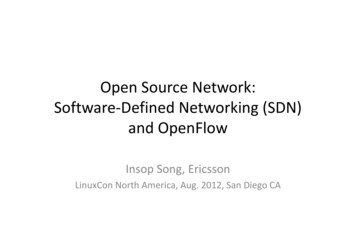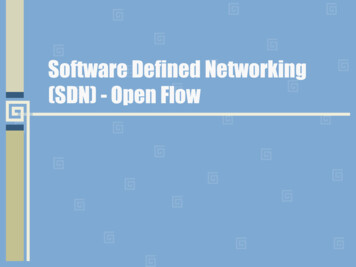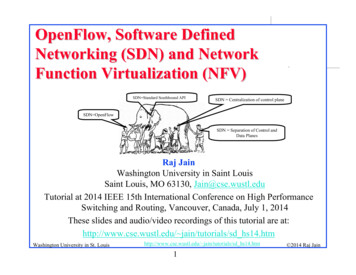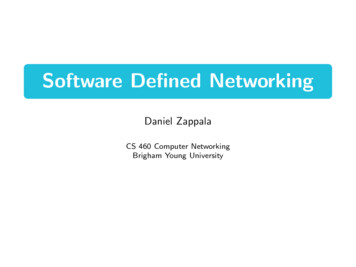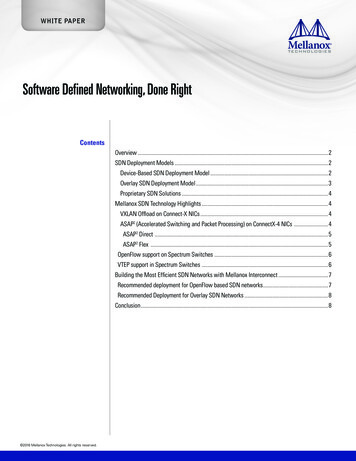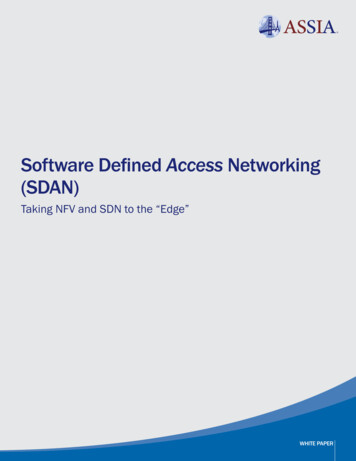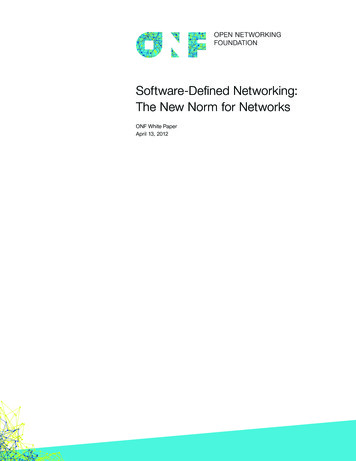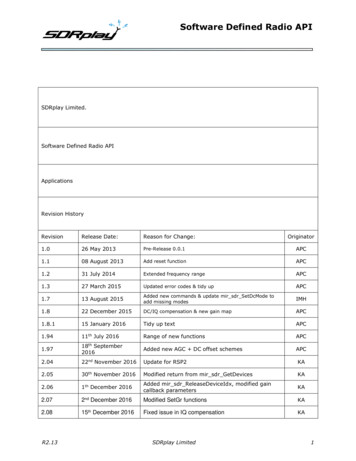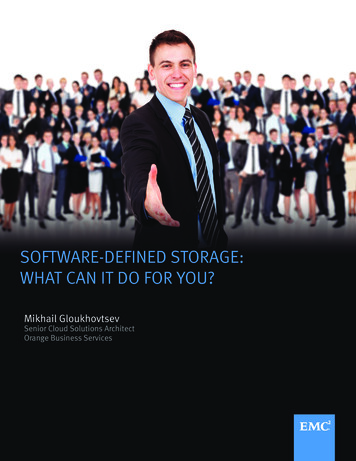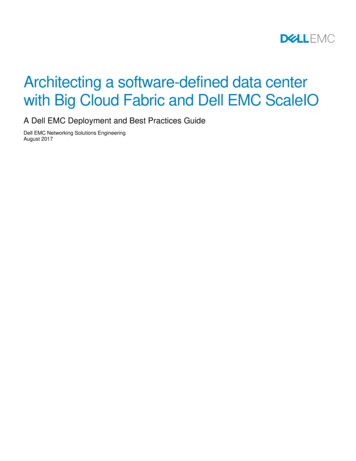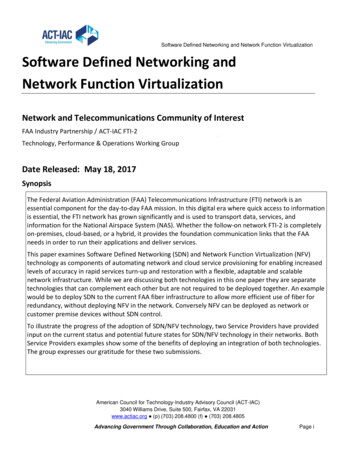
Transcription
Software Defined Networking and Network Function VirtualizationSoftware Defined Networking andNetwork Function VirtualizationNetwork and Telecommunications Community of InterestFAA Industry Partnership / ACT-IAC FTI-2ACT-IAC DRAFTTechnology, Performance & Operations Working GroupDate Released: May 18, 2017SynopsisThe Federal Aviation Administration (FAA) Telecommunications Infrastructure (FTI) network is anessential component for the day-to-day FAA mission. In this digital era where quick access to informationis essential, the FTI network has grown significantly and is used to transport data, services, andinformation for the National Airspace System (NAS). Whether the follow-on network FTI-2 is completelyon‐premises, cloud‐based, or a hybrid, it provides the foundation communication links that the FAAneeds in order to run their applications and deliver services.This paper examines Software Defined Networking (SDN) and Network Function Virtualization (NFV)technology as components of automating network and cloud service provisioning for enabling increasedlevels of accuracy in rapid services turn-up and restoration with a flexible, adaptable and scalablenetwork infrastructure. While we are discussing both technologies in this one paper they are separatetechnologies that can complement each other but are not required to be deployed together. An examplewould be to deploy SDN to the current FAA fiber infrastructure to allow more efficient use of fiber forredundancy, without deploying NFV in the network. Conversely NFV can be deployed as network orcustomer premise devices without SDN control.To illustrate the progress of the adoption of SDN/NFV technology, two Service Providers have providedinput on the current status and potential future states for SDN/NFV technology in their networks. BothService Providers examples show some of the benefits of deploying an integration of both technologies.The group expresses our gratitude for these two submissions.American Council for Technology-Industry Advisory Council (ACT-IAC)3040 Williams Drive, Suite 500, Fairfax, VA 22031www.actiac.org (p) (703) 208.4800 (f) (703) 208.4805Advancing Government Through Collaboration, Education and ActionPage i
Software Defined Networking and Network Function VirtualizationAmerican Council for Technology-Industry Advisory Council (ACT-IAC)The American Council for Technology (ACT) – Industry Advisory Council (IAC) is a non-profiteducational organization established to create a more effective and innovative government.ACT-IAC provides a unique, objective and trusted forum where government and industryexecutives are working together to improve public services and agency operations through theuse of technology. ACT-IAC contributes to better communications between government andindustry, collaborative and innovative problem solving and a more professional and qualifiedworkforce.ACT-IAC DRAFTThe information, conclusions and recommendations contained in this publication wereproduced by volunteers from industry and government advisors supporting the objective ofmore effective and innovative use of technology by federal agencies. ACT-IAC volunteersrepresent a wide diversity of organizations (public and private) and functions. These volunteersuse the ACT-IAC collaborative process, refined over thirty years of experience, to produceoutcomes that are consensus-based. The findings and recommendations contained in thisreport are based on consensus and do not represent the views of any particular individual ororganization.To maintain the objectivity and integrity of its collaborative process, ACT-IAC does not acceptgovernment funding.ACT-IAC welcomes the participation of all public and private organizations committed toimproving the delivery of public services through the effective and efficient use of IT. Foradditional information, visit the ACT-IAC website at www.actiac.org.Networks & Telecommunications (N&T) Community of Interest (COI)The N&T COI mission is to provide clarity, impartial feedback, and points for consideration onnetworks and telecom issues identified in collaboration with the federal government andindustry. The N&T COI provides a forum where government and industry executives areworking together on key telecommunication issues such as interoperability, informationsharing, communications architectures, wireless technologies, converged internet protocolbased services, security, and continuity of service. The N&T COI established a working group tofacilitate collaboration between government and industry on matters concerning the upcomingFTI-2 effort.American Council for Technology-Industry Advisory Council (ACT-IAC)3040 Williams Drive, Suite 500, Fairfax, VA 22031www.actiac.org (p) (703) 208.4800 (f) (703) 208.4805Advancing Government Through Collaboration, Education and ActionPage ii
Software Defined Networking and Network Function VirtualizationDisclaimerThis document has been prepared to contribute to a more effective, efficient and innovativegovernment. The information contained in this report is the result of a collaborative process inwhich a number of individuals participated. This document does not – nor is it intended to –endorse or recommend any specific technology, product or vendor. Moreover, the viewsexpressed in this document do not necessarily represent the official views of the individuals andorganizations that participated in its development. Every effort has been made to presentaccurate and reliable information in this report. However, ACT-IAC assumes no responsibilityfor consequences resulting from the use of the information herein.This paper was prepared by ACT-IAC after consultation with the Federal AviationAdministration. The information and opinions contained herein are those of the ACT-IAC andare not a reflection of any planned strategy or approach to FTI-2 by the FAA.ACT-IAC DRAFTCopyright American Council for Technology, 2017. This document may not be quoted, reproducedand/or distributed unless credit is given to the American Council for Technology-IndustryAdvisory Council.Further InformationFor further information, contact the American Council for Technology-Industry Advisory Councilat (703) 208-4800 or www.actiac.org.American Council for Technology-Industry Advisory Council (ACT-IAC)3040 Williams Drive, Suite 500, Fairfax, VA 22031www.actiac.org (p) (703) 208.4800 (f) (703) 208.4805Advancing Government Through Collaboration, Education and ActionPage iii
Software Defined Networking and Network Function VirtualizationTABLE OF CONTENTSSECTIONPAGEIntroduction . 6What is Software Defined Networking and Network Function Virtualization? . 6Traditional Network Model . 8Hybrid Control Plane Model . 9Network Function Virtualization . 10Service Provider Prospective — Service Provider One (SP1). 13ACT-IAC DRAFTSP1’s Software-Defined Network Architecture . 14SP1’s Software-Defined Network Architecture Security Approach . 14Transforming the Network . 16SP1’s SDN Approach. 16Ensuring SDN’s Reliability . 17The Service Provider’s NFV Approach . 18Ensuring NFV’s Reliability . 19Carrier Perspective — Service Provider Two (SP2) . 20Considerations and Potential Benefits in Applying the fiber optic based SDN/NFV Technologyto FAA Networks . 21Backbone Availability/Survivability . 22Background . 22Carrier Perspective . 22System Integrator Perspective . 23Access Cost Reduction. 24Background . 24System Integrator Perspective . 24Carrier Perspective . 24O&M at Remote Sites . 25Background . 25Hardware Provider Perspective . 25Carrier Perspective . 26System Integrator Perspective . 26Technology Refresh . 27Background . 27Hardware Provider Perspective . 27System Integrator Perspective . 28Carrier Perspective . 28SDN/NFV Operational Issues . 28Observations and Suggestions . 30Authors & Affiliations . 31American Council for Technology-Industry Advisory Council (ACT-IAC)3040 Williams Drive, Suite 500, Fairfax, VA 22031www.actiac.org (p) (703) 208.4800 (f) (703) 208.4805Advancing Government Through Collaboration, Education and ActionPage iv
Software Defined Networking and Network Function VirtualizationLIST OF FIGURESFigure 1. Traditional Network Model . 8Figure 2. Centralized Control Plane Model . 9Figure 3. Hybrid Control Plane Model . 9Figure 4. Transforming the Network . 16Figure 5. SP1 NFV Approach . 18Authors & Affiliations . 31ACT-IAC DRAFTAmerican Council for Technology-Industry Advisory Council (ACT-IAC)3040 Williams Drive, Suite 500, Fairfax, VA 22031www.actiac.org (p) (703) 208.4800 (f) (703) 208.4805Advancing Government Through Collaboration, Education and ActionPage v
Software Defined Networking and Network Function VirtualizationINTRODUCTIONThe Federal Aviation Administration (FAA) Telecommunications Infrastructure (FTI) network isan essential component for the day-to-day FAA mission. In this digital era where quick access toinformation is essential, the FTI network has grown significantly and is used to transportdifferent types of voice and data services, and other information for the National Airspace. It isanticipated that the FTI-2 network will be deployed on‐premises in both the metro area as wellas wide area network to provide communication links and other associated services that theFAA needs in order to fulfill their mission. Software Defined Networking (SDN) and NetworkFunction Virtualization (NFV) are state of the art technologies to efficiently and effectivelyautomate networking and cloud infrastructure providing adaptability, flexibility and scalabilityof service offerings.ACT-IAC DRAFTSDN with network elements based on NFV, open network hardware and x86 platforms withDynamically Reconfigurable - Field Programmable Gate Array (DR-FPGA) support integration ofapplications and networks for efficiency and performance which may be applied locally, in themetro area and Wide Area Network (WAN), at the data center, or in the cloud. Administeringapplication services is difficult and sometimes impossible with today’s static networks based onvendor specific network elements. For that reason, SDN and NFV are being deployed in variousnetworks to innovate telecommunications by integrating networks with applications to reducethe administrative burden, while decreasing the time it takes to deliver new services. Thecurrent FTI network and National Airspace System (NAS) includes a large percentage ofnarrowband channelized Time Division Multiplexing (TDM) circuits and custom applications.(Note: This White Paper uses the term TDM in a limited context and not the more general useof the term in all serial frame and packet based connections.) To be most effective SDNcontrolled links are based on broadband capacity to support shared services and therefore arenot usually associated with narrowband, channelized TDM circuits which usually support singlefixed functions. SDN technology has not been widely applied to legacy applications because oflack of software transparency and difficultly in code modifications. However externalapplication profiles can be associated with those legacy applications when they are initiated.For many organizations, cloud-based application and data centers have been the early adaptorsof premise based SDN with NFV due to the velocity of network changes, modest bandwidthrequirements and availability of repurposed computing resources. FTI-2 is primarily a WANacquisition so this paper will focus on the WAN aspects of SDN/NFV technology which is usuallya more stringent case than on premise versions. This paper will first provide an overview of theSDN / NFV technology, then provide examples of how SDN/NFV is being deployed with twoService providers, and finally provide some analysis of potential deployment of the technologywithin FTI-2.WHAT IS SOFTWARE DEFINED NETWORKING AND NETWORK FUNCTION VIRTUALIZATION?SDN is a network architecture that separates control plane functions from the data planemigrating those functions which include network intelligence, management and policymakingAmerican Council for Technology-Industry Advisory Council (ACT-IAC)3040 Williams Drive, Suite 500, Fairfax, VA 22031www.actiac.org (p) (703) 208.4800 (f) (703) 208.4805Advancing Government Through Collaboration, Education and ActionPage 6
Software Defined Networking and Network Function Virtualizationto a controller device or application. This architecture tracks what occurred in the PublicSwitched Voice Network (PSTN) narrowband services in the mid to late seventies with theadvent and deployment of SS#7. The control messages were moved to a separate control planethat had north and south bound interfaces to control the circuit switches involved in the voicepath as well as receive different command and policy data from associated databases.For a number of years, packet switched data networks utilized in-band route updates tomanage which paths packets traversed through the network. Individual packet routing is acomputationally intensive process that does not scale well in large carrier and Internetbackbone networks. It was observed that a vast majority of packets occurred in either onedirectional or bidirectional flows that could be switched through the network with layer 2 or 3tunnels such as L2TP or MPLS. Label Switch Routing functionality was added to edge and corerouters to tag flows and use that tag switch the packets without requiring route pathdetermination at each hop in the path. To better manage an aggregate number of IP flows theOpenFlow protocol was developed and implemented as one of the first standards based SDNtechnologies. This protocol has been applied at all three layers of the communications stackwith optical, electronic/digital and narrow or broadband frame switching, and IP flow switching.ACT-IAC DRAFTThe SDN architecture is dynamic, centrally manageable, cost-effective, and adaptable, making itideal for the high-bandwidth, dynamic nature of today’s applications. The control plane on anetwork device generally is anything that is needed in order to get routing, forwarding orswitching working on that device; in other words, the control plane is the “brain” of thenetwork device. Control plane management packets are destined to, or locally originated by,the network devices themselves. The data plane is called the forwarding plane for packetdevices and networks; the forwarding plane forwards packets through a network device that isnot destined for that device. In multi-layer networks the data plane also refers to the digitalpacket or frame transport layer as well as the underlying foundation optical transport layer.When the network control and forwarding plane functions are separated in the network,network elements have a North bound application interface and a South bound network devicecontrol interface. The network device control plane becomes directly programmable from acentral controller and enables the underlying infrastructure to be abstracted for bothmanagement and service delivery purposes. This standard abstraction can increase the level ofautomation of a network like FTI-2 network and reduce the level of manual provisioning fornetwork services. For example, when a new network device needs to be added to the network,a centralized controller can automatically identify the device and provide a configuration forthe new device. This model provides exceptional levels of visibility into the network as well asplanning and business intelligence. Some of the more relevant benefits of SDN are: Programmable: Control and underlying data planes are directly configurablebecause the control packets are removed from the data forwarding and switchingplanes. It allows rapid configuration and management changes, in-depth anddistributed security, and optimization of resources quickly via real timeAmerican Council for Technology-Industry Advisory Council (ACT-IAC)3040 Williams Drive, Suite 500, Fairfax, VA 220
May 18, 2017 · (Note: This White Paper uses the term TDM in a limited context and not the more general use of the term in all serial frame and packet based connections.) To be most effective SDN controlled links are based on broadb
